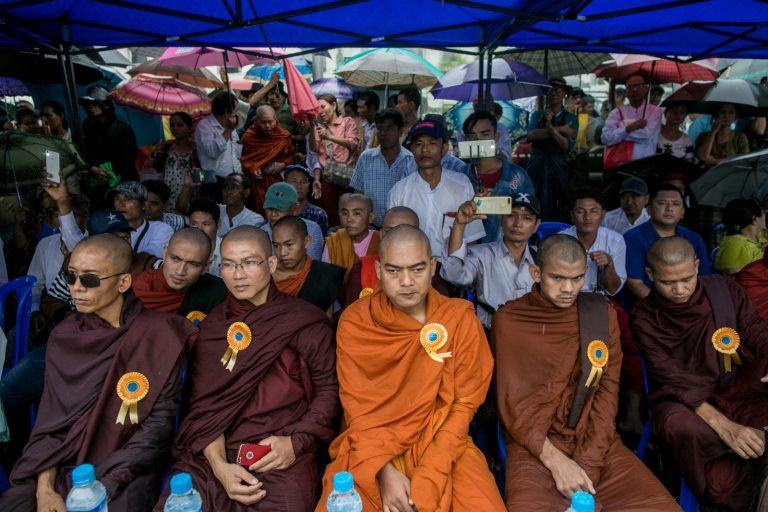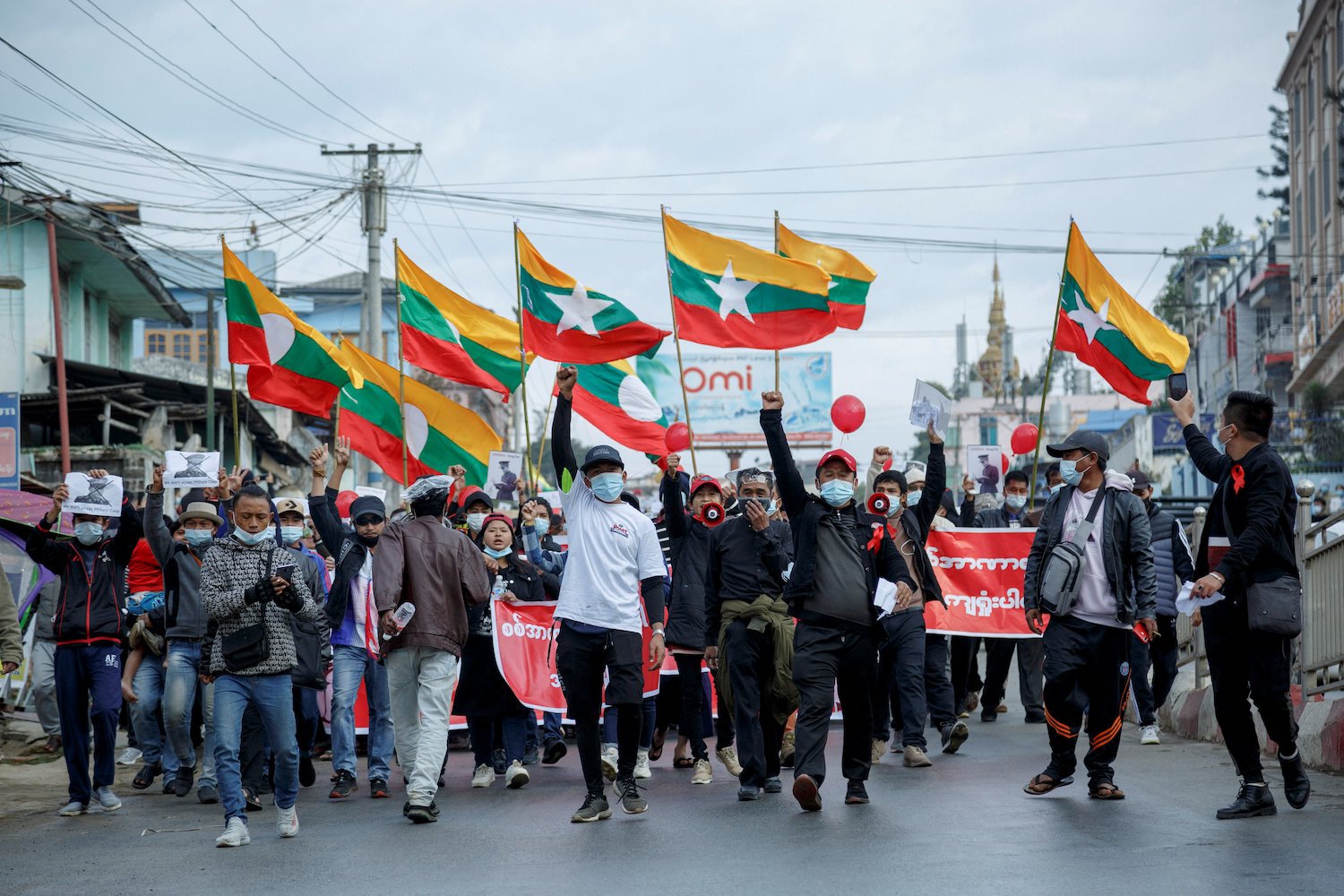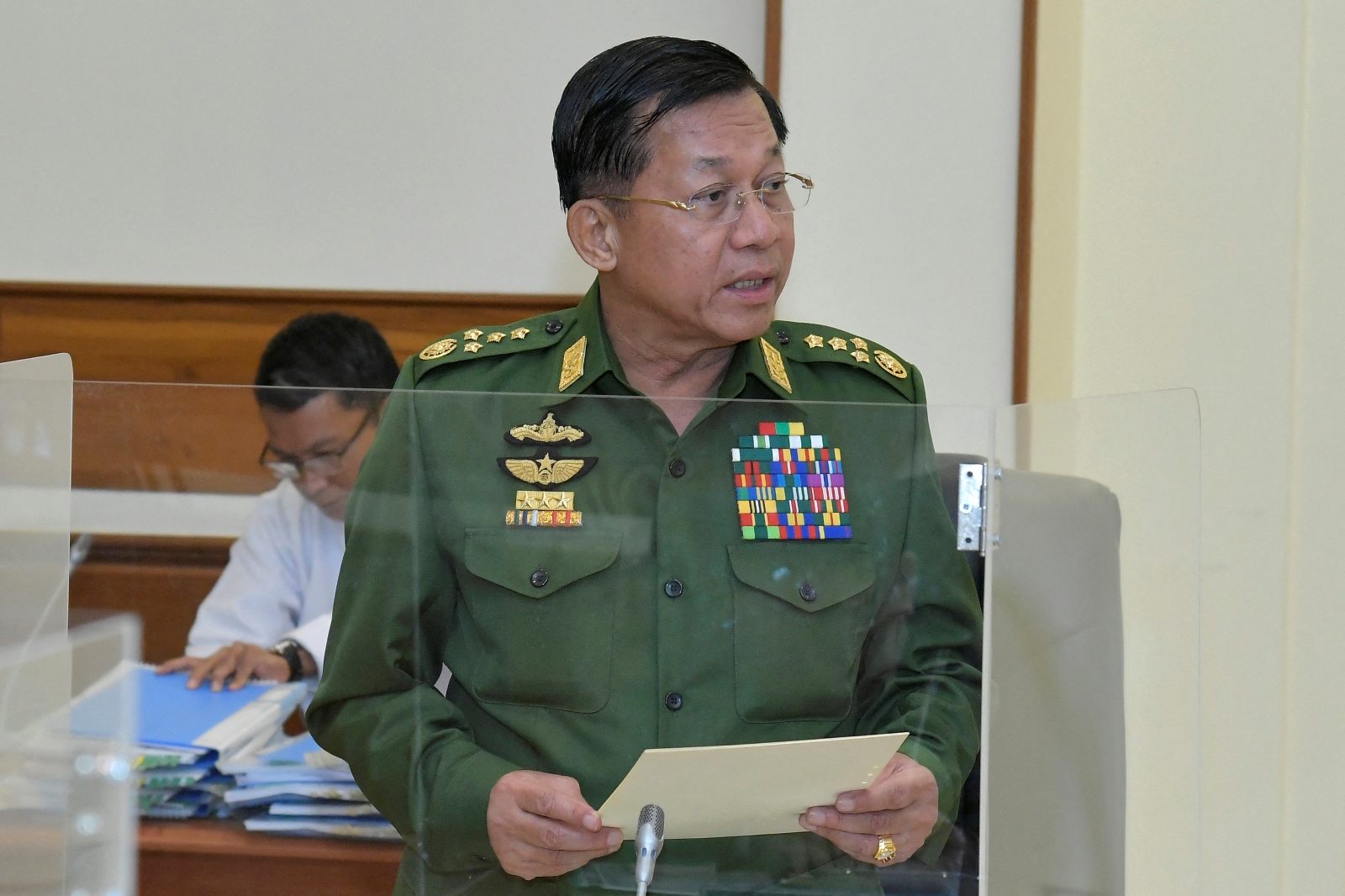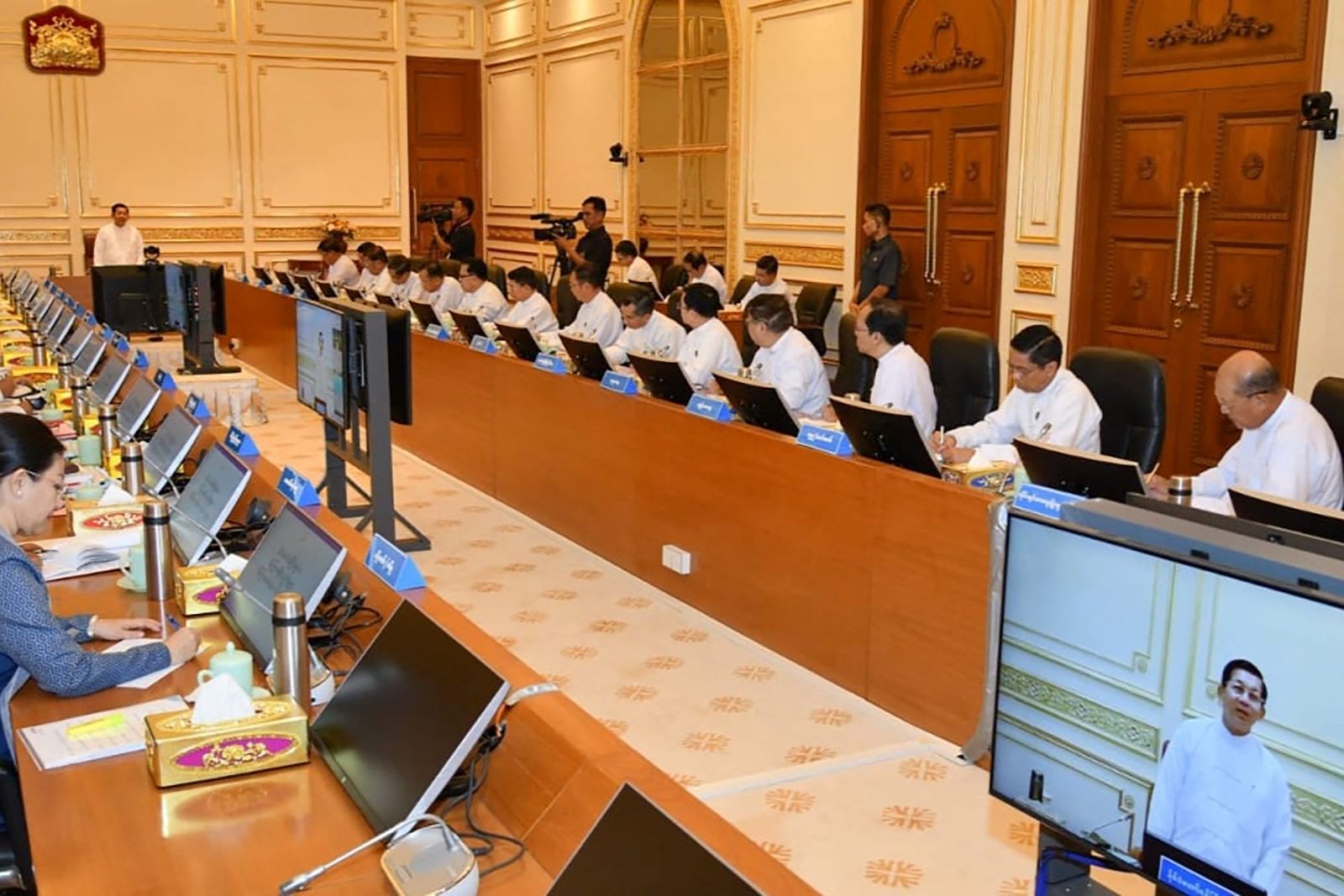Min Aung Hlaing is set to unveil a gigantic Buddha statue in Nay Pyi Taw, but critics say the compound reveals more about the senior general’s superstitions, megalomania and oppressive tendencies than his devotion to religion.
By FRONTIER
Security is tight at the compound in the military-dominated capital of Nay Pyi Taw, where the junta has built what it claims to be, at 25 metres (81 feet), the world’s tallest statue of a sitting Buddha made with marble. During an attempted visit on March 28, Frontier was turned away by five armed soldiers standing guard.
A trishaw driver, who brought a construction worker to the site in April, told Frontier everybody entering the compound is searched and the labourers must leave their identity cards with security forces while they’re inside.
“There are many religious buildings in the compound. It’s magnificent,” he said.
But while ordinary people were turned away from the site while it was still under construction, military and business elites seemed to have no trouble visiting.
U Khin Yi, chairman of the military-backed Union Solidarity and Development Party, wrote on Facebook in February that he visited the site with his family. He praised the workmanship of Tatmadaw engineers and said the 91-hectares (225 acres) compound included many Buddha images, religious buildings, a mucalinda pond with a statue of the Buddha protected by a snake and stupas with stone inscriptions.
But, despite the magnificent appearance of the site, many see it as a reminder of the brutality of the military and the megalomania of its leader, Senior General Min Aung Hlaing.
“Regardless of whether Min Aung Hlaing builds the world’s biggest Buddha or biggest monastery, his sins can’t be erased. He’s a devil,” said a woman from Nay Pyi Taw’s Pyinmana Township, who is convinced he fears karmic retribution. “Because he tortured and slaughtered people, he is afraid. So, he’s trying to cover up his sins with religious deeds.”
Since seizing power in February 2021, Min Aung Hlaing has overseen violent crackdowns on peaceful protesters and a relentless military campaign against pro-democracy armed groups, killing thousands of civilians.
While the statue has supposedly been in the works since before the coup, state media ramped up coverage just after the military took charge – then referring to it as Bhumi Phassa Mudra. The final form will be unveiled during an elaborate ceremony tomorrow.
In a July press conference, military spokesperson Major-General Zaw Min Tun said the project was wholly undertaken by the military and Myanmar Engineers Council, with the support of public donations, and estimated it would cost US$40 million.
The regime appealed to members of the public for donations, advertising bank accounts they could transfer funds to in state media. But the vast majority of the money has come from cronies and other business elites.
The regime announced on February 10 that donations from the public reached K810 million (about $385,000), but in June it said over K16 billion ($7.6 million) was given by just 101 businessmen. The top two donors, at K2 billion, were U Khin Maung Aye from CB Bank and U Kyay from Wai Mar company. Another big spender was U Thein Win Zaw, a crony who has been accused of acting as a proxy for the military by purchasing a telecommunications company.
But despite the huge amount of money being thrown around, manual labourers are being paid a pittance. Construction workers said they work from 8am to 5:30pm, earn K7,000-K20,000 per day, depending on their role – around US$3.3-9.4 – and are paid every three days.
“I can’t afford to care if anybody criticises me for working on the construction of a Buddha statue under the military council,” said a 28-year-old labourer from Lewe Township who has been working there for around one year. “If I didn’t work here, I might have starved to death.”
What’s in a name?
A taxi driver was able to take a Frontier reporter to the statue but said he didn’t even know its name.
“We only know that Min Aung Hlaing is building the Min Aung Hlaing pagoda,” said another woman from Zabuthiri Township. “We don’t know its name and we don’t care to know it.”
Min Aung Hlaing named the statue Maravijaya, supposedly in consultation with senior monks close to him in the state-run State Sangha Maha Nayaka Committee.
Sayadaw U Wayama, a monk with the anti-regime Spring Revolution Sangha Network, fiercely criticised his colleagues who have advised the junta leader.
“It must be said that his mentor monks have helped him in lying, cheating and concealing his unfair and brutal acts,” he said.
U Wayama said the name of the Buddha statue reveals that Min Aung Hlaing is less interested in worship than he is in violently crushing his enemies.
“Take a look at the name of the statue. ‘Mara’ means enemy, ‘Vijaya’ means conqueror,” he said. “Min Aung Hlaing wants to conquer all of his opponents. He built the statue with this attitude.”

The Buddha conquered a demon called Mara who embodied metaphysical concepts like greed, hate or death. But Min Aung Hlaing’s main enemies are his own people, who have risen up against military rule.
Many have also noticed the Buddha image seems to reveal the military’s obsession with the number nine. The entire structure is 81 feet tall, made up of a 63-foot-tall statue and an 18 foot altar. It weighs a total of 5,292 tonnes with the altar making up 3,510 tonnes and the statue another 1,782. All of these numbers have digits adding up to nine.
And it doesn’t end there. The regime said there are 720 stone plaques with miniature pagodas, and the compound took 1,143 days to build, starting from June 14, 2020. A total of 900 monks are expected to attend the opening ceremony on August 1, according to Zaw Min Tun.
The Tatmadaw’s obsession with the number nine stems back to the country’s first military dictator, Ne Win, who seized power in a 1962 coup. Historian David Steinberg wrote that Ne Win believed nine was his lucky number based on the advice of an astrologer. In 1987, in order to crack down on the pervasive black market, he even changed currency notes to multiples of nine, which destabilised the economy and likely contributed to the mass protest movement in 1988.
Open to the public
By building an enormous Buddha statue, Min Aung Hlaing has followed in the footsteps of past military dictators, who tried to emulate precolonial Myanmar kings who acted as patrons of Buddhism. In 1980, Ne Win consecrated the Maha Wizaya Pagoda, just down the road from Yangon’s Shwedagon Pagoda, the country’s most important temple.
After moving the capital to Nay Pyi Taw, Than Shwe in 2009 unveiled the Uppatasanti Pagoda, a virtually identical replica of Shwedagon. Seven years earlier, he built a 560-ton Buddha statue in Yangon’s Insein Township, made of marble from Sagyin Hill in Madaya Township, Mandalay Region. The marble for Min Aung Hlaing’s statue has come from the same source.
“It’s very hard, resistant to weathering and a pure white colour,” said a monk from Ayeyarwady Region, who has attended regime-orchestrated religious ceremonies at the Maravijaya. “Sagyin marble is the best for sculptures.”
While Uppatsanti and Maha Wizaya have never attracted much foot traffic, Min Aung Hlaing is hoping his Buddha compound will be more successful, and is doing much to lure visitors.
The road leading to the compound’s front entrance, named Sabel Road, was previously just two bumpy, unfinished lanes. Today, it’s a four-lane smoothly-paved road lined with new flowering trees and lamp posts, directly connected to Yaza Thingaha Road, one of the capital’s main thoroughfares.
Another freshly paved four-lane road was built at the back of the compound, connecting to the Yangon-Mandalay Expressway. While off limits to the public for now, this segment would connect the Buddha statue directly to Myanmar’s two biggest cities.
At the July press conference, Zaw Min Tun said members of the general public will be able to visit the Buddha statue after the consecration ceremony on August 1. He said entry would be free of charge from August 1-16, but after that ticket fees will be collected from local and foreign visitors.
U Wayama scoffed at the idea that foreign tourists would visit.
“Visitors won’t come to a country where so many people are being killed,” he said.
A woman from Nay Pyi Taw said given the politicisation of the statue, the entrance fees wouldn’t be a factor in whether local people visit.
“Those who don’t want to visit wouldn’t visit even if it was free,” she said.







